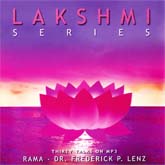
Lakshmi Series
Dharma and Karma
Dharma is the truth.
Dharma is the truth throughout the ages. There are two types of dharma, universal dharma and individual dharma. To understand one, it's really necessary to understand the other. They can't be separated, although human beings try to.
Universal dharma is existence. We begin with the assumption that there's a primal cause for all things, there is an omnipresent reality or being that we call God, the self, nirvana, eternity. This omnipresent force or reality is existence. All of the worlds, realities, beings, experiences and times that we call existence come forth from and are directed by this reality.
Human beings like to think of God as a big person. We identify through the medium of ourselves, so we explore and come to know, to some extent, our own tonal ranges. We know that human beings think a certain way, feel a certain way, see life in a certain way. And so we assume that eternity or God must do that, and we are, in fact, correct, to an extent, since God exists in all things, at all times and all places and at the same time is beyond all times and places and things. God exists as human beings. The aspect of God that is each of us does see and feel existence in a certain way - the way we see and feel existence.
But God is not limited or bound by the human mode of perception. God may be a tree: growing, experiencing wind, heat, the passage of time in a very different way. God is in a stone that experiences a different type of awareness. You may look at a stone and say, "Well, there's no life there." But a physicist will correct you. A physicist will point out that there is as much life in a stone as there is in a human being. While the stone may not be, or appear to be, animate to you - it doesn't get up and walk around and move and talk and dance and perform - the molecular structure of the stone is in a constant state of motion. The atoms, the electrons, the protons, neutrons, sub-atomic particles, the worlds within worlds that exist within a fraction of an ounce of a stone, are galaxies; they're fathomless. And who is to say that those atoms and those electrons don't have consciousness, don't have awareness, simply because we are not aware of their awareness? Yet are we not made up of the same thing? Are we not made up of galaxies of universes, of sub-atomic particles that whirl and whirl together to form a certain aggregate which we call a human being?
Everything has awareness. Simply because a person does not see that does not mean that awareness does not exist. It was only a hundred or two hundred years ago that human beings were unaware of bacteria and viruses and their effects. The plague would roll into town and devastate 90 percent of the population, and people would have no idea how or why. That which was invisible was the causative agent, the bacteria or the virus. Today, through the marvels of the microscope, we know about the existence of these things. So simply because we don't see something, we're not currently aware of it, doesn't mean that it doesn't exist. In spiritual practice and in all learning, we have to constantly be open to vision and revision. We need to be able to see beyond the known, to expose ourselves to that which we are not familiar with.
At the same time, as new information and knowledge and data, new ways of seeing life enter our being, we must be able to push aside outmoded ideas, ways of thinking, ways of examining existence which we find are incomplete. Young children, of course, find this very easy to do because they don't have a lot of concepts and ideas. A child learns one, two or three languages very quickly. The child can accept technology because the child is not wrestling with conditioning. The child hasn't been programmed.
In spiritual practice we all become children again.

